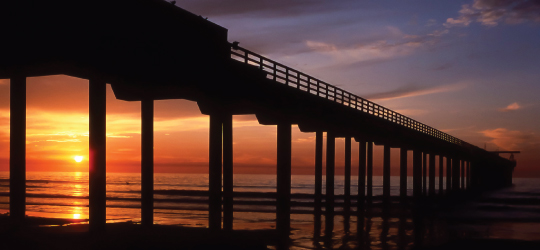Legacy
Established in 1960, UC San Diego has been shaped by exceptional scholars who aren’t afraid to push boundaries, challenge expectations and redefine conventional wisdom in order to make our world better. Indeed, one of the university’s founders was Roger Revelle, a pioneer of climate change research. Since then, UC San Diego has built upon that visionary legacy to become a leader in sustainable solutions. See the timeline below to learn about important campus sustainability milestones.
- 1961: Scripps Institution of Oceanography geochemist Charles David Keeling produces data showing that carbon dioxide levels were rising steadily in what became known as the “Keeling Curve,” a measurement of rising carbon dioxide levels in the atmosphere.
- 1960s: Cogeneration plant comes online. The 30 megawatt natural-gas-fired plant's combined heat and power system generates electricity to run lights and equipment and produces steam for heating, ventilation and air conditioning for the campus.
- 1989: Master Plan Study for UC San Diego completed, the first plan for the campus that incorporated sustainable building guidelines and articulated environmental stewardship.
- 1995: Mario Molina, who joined the Department of Chemistry and Biochemistry and Scripps Institution of Oceanography in 2004, shares the 1995 Nobel Prize in chemistry for helping to reveal that a common class of chemicals damages Earth’s ozone layer.
- 2005: Chancellor Marye Ann Fox makes sustainability a top campus priority, which soon results in a wide range of green operational milestones and top national sustainability rankings.
- 2007: 21 Scripps Institution of Oceanography scientists join thousands of scientists worldwide in sharing the 2007 Nobel Peace Prize awarded to the Intergovernmental Panel on Climate Change (IPCC) and Former Vice President Al Gore.
- 2008: The San Diego Center for Algae Biotechnology (SD-CAB) is established by researchers from The Scripps Research Institute, UC San Diego and Scripps Institution of Oceanography in partnership with private industry to propel research discoveries in energy and economic solutions.
- 2008: The first solar panels begin appearing on campus roofs. Within several years, many campus buildings and parking structures will be covered with flat panel photovoltaics, generating 2.3 megawatts of power.
- 2009: UC San Diego receives its first LEED certification for the Robert Paine Scripps Seaside Forum. LEED – Leadership in Energy and Environmental Design – is a third party certification program developed by the U.S. Green Building Council.
- 2009: The Sustainability Resource Center opens, a one-stop shop where students can learn about green jobs, sustainability-related topics, how to conserve energy and water, and find eco-friendly products. The center was later awarded LEED “Gold” certification by the U.S. Green Building Council.
- 2009: Housing Dining and Hospitality begins the student Econauts program, which assists in environmental education and outreach to the students who live on campus.
- 2010: UC San Diego wins an EPA energy-efficiency award for its co-generation plant, which provides 85 percent of the campus’s annual electricity needs and saves $8 million a year in energy costs.
- 2010: UC San Diego’s vehicle fleet is named one of America’s greenest at the Government Green Fleet Awards. Hybrids, electric and alternative-fuel vehicles make up 60 percent of the campus fleet.
- 2011: A 2.8 megawatt fuel cell begins operating at UC San Diego, the largest such cell on any college campus. The fuel cell uses methane gas from a local wastewater treatment plant.
- 2011: UC San Diego becomes the first California university to achieve “Gold” STARS sustainability rating, administered by the Association for the Advancement of Sustainability in Higher Education (AASHE).
- 2012: Campus awarded first LEED Platinum certification for the Charles David Keeling Apartments, a first for any structure at UC San Diego and a first for any residential housing building in the University of California system.
- 2012: A new Organized Research Unit is established that focuses on “Food and Fuel for the 21st Century” and supports development of innovative, sustainable and commercially viable solutions for the renewable production of food, energy and more.
- 2013: The Princeton Review names UC San Diego one of the most environmentally responsible “green colleges” in the U.S. and Canada.
- 2015: Biologists and chemists partner with the local surfing industry to create the world’s first algae-based, sustainable surfboard.
- 2015: UC San Diego hosts UC Summit on Carbon and Climate Neutrality, which delivers 10 scalable solutions for slowing climate change.
